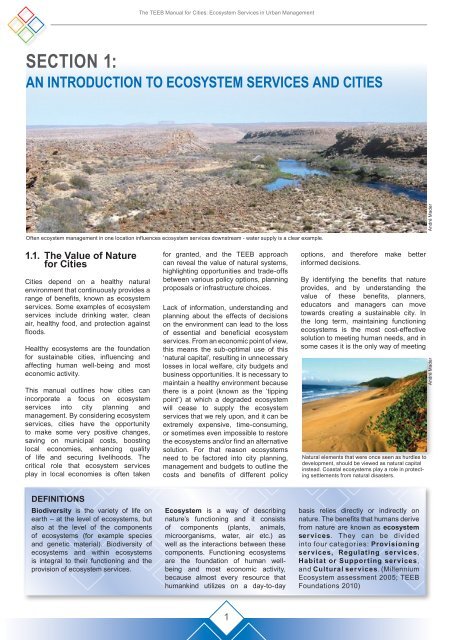TEEB Manual for Cities
TEEB Manual for Cities
TEEB Manual for Cities
You also want an ePaper? Increase the reach of your titles
YUMPU automatically turns print PDFs into web optimized ePapers that Google loves.
The <strong>TEEB</strong> <strong>Manual</strong> <strong>for</strong> <strong>Cities</strong>: Ecosystem Services in Urban ManagementSection 1:An introduction to ecosystem services and citiesOften ecoystem management in one location influences ecosystem services downstream - water supply is a clear example.1.1. The Value of Nature<strong>for</strong> <strong>Cities</strong><strong>Cities</strong> depend on a healthy naturalenvironment that continuously provides arange of benefits, known as ecosystemservices. Some examples of ecosystemservices include drinking water, cleanair, healthy food, and protection againstfloods.Healthy ecosystems are the foundation<strong>for</strong> sustainable cities, influencing andaffecting human well-being and mosteconomic activity.This manual outlines how cities canincorporate a focus on ecosystemservices into city planning andmanagement. By considering ecosystemservices, cities have the opportunityto make some very positive changes,saving on municipal costs, boostinglocal economies, enhancing qualityof life and securing livelihoods. Thecritical role that ecosystem servicesplay in local economies is often taken<strong>for</strong> granted, and the <strong>TEEB</strong> approachcan reveal the value of natural systems,highlighting opportunities and trade-offsbetween various policy options, planningproposals or infrastructure choices.Lack of in<strong>for</strong>mation, understanding andplanning about the effects of decisionson the environment can lead to the lossof essential and beneficial ecosystemservices. From an economic point of view,this means the sub-optimal use of this‘natural capital’, resulting in unnecessarylosses in local welfare, city budgets andbusiness opportunities. It is necessary tomaintain a healthy environment becausethere is a point (known as the ‘tippingpoint’) at which a degraded ecosystemwill cease to supply the ecosystemservices that we rely upon, and it can beextremely expensive, time-consuming,or sometimes even impossible to restorethe ecosystems and/or find an alternativesolution. For that reason ecosystemsneed to be factored into city planning,management and budgets to outline thecosts and benefits of different policyoptions, and there<strong>for</strong>e make betterin<strong>for</strong>med decisions.By identifying the benefits that natureprovides, and by understanding thevalue of these benefits, planners,educators and managers can movetowards creating a sustainable city. Inthe long term, maintaining functioningecosystems is the most cost-effectivesolution to meeting human needs, and insome cases it is the only way of meetingNatural elements that were once seen as hurdles todevelopment, should be viewed as natural capitalinstead. Coastal ecosystems play a role in protectingsettlements from natural disasters.André Mader André MaderDefinitionsBiodiversity is the variety of life onearth – at the level of ecosystems, butalso at the level of the componentsof ecosystems (<strong>for</strong> example speciesand genetic material). Biodiversity ofecosystems and within ecosystemsis integral to their functioning and theprovision of ecosystem services.Ecosystem is a way of describingnature’s functioning and it consistsof components (plants, animals,microorganisms, water, air etc.) aswell as the interactions between thesecomponents. Functioning ecosystemsare the foundation of human wellbeingand most economic activity,because almost every resource thathumankind utilizes on a day-to-daybasis relies directly or indirectly onnature. The benefits that humans derivefrom nature are known as ecosystemservices. They can be dividedinto four categories: Provisioningservices, Regulating services,Habitat or Supporting services,and Cultural services. (MillenniumEcosystem assessment 2005; <strong>TEEB</strong>Foundations 2010)1
















